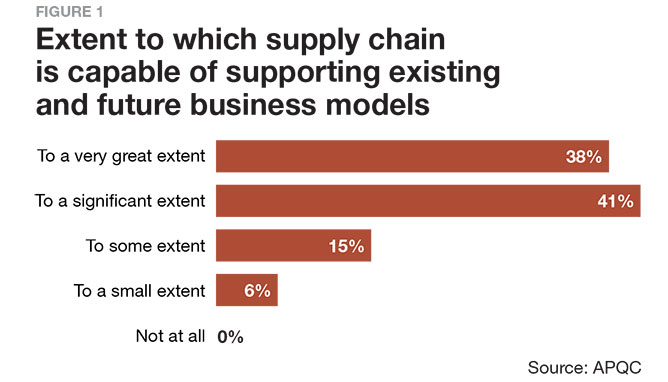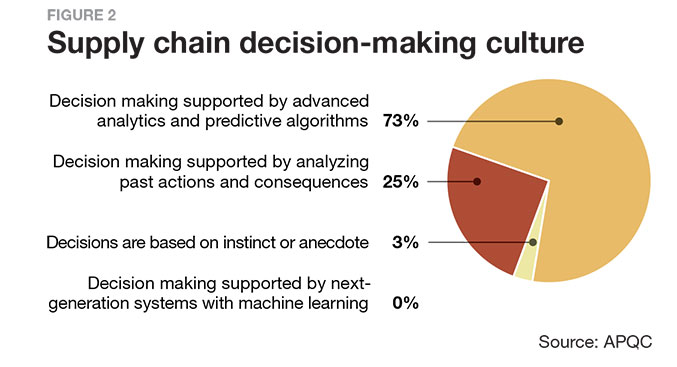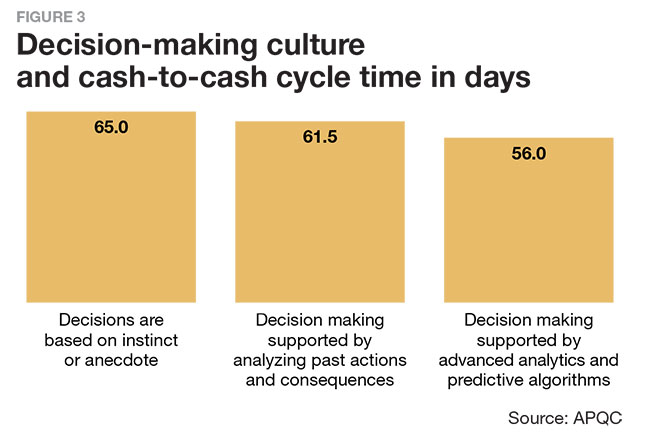Sorry, but your login has failed. Please recheck your login information and resubmit. If your subscription has expired, renew here.
September-October 2020
If it’s September, it must be time for Gartner’s take on the Top 25 supply chains. This marks the 16th year that Gartner has put together its list of the leading supply chains across he globe, a list that now also includes an additional five Masters. Those are companies that so consistently made the list year in and year out that they warranted a category all their own. You can read the article, and the web only material we publish on scmr.com, to find out what it takes to become a supply chain leader. Browse this issue archive.Need Help? Contact customer service 847-559-7581 More options
COVID-19 and the resulting economic downturn have challenged organizations to re-evaluate their ideas about how to optimize the supply chain. Rather than focusing solely on cost and market share, organizations must now consider how to address risk and meet strategic goals while achieving efficiency. This responsibility falls primarily on supply chain planners, who must consider the need to keep logistics modes flexible, quickly react to unforeseen high-impact events and pivot to address shifts in demand.
Being able to balance these needs is essential to building the supply chain of the future. Organizations leading the way in supply chain planning exhibit key behaviors that drive their superior performance and make them well suited for both weathering the current uncertainty and emerging from it positioned for success.
These organizations keep themselves flexible to react quickly to unanticipated interruptions, yet they also plan for the future by ensuring that they can support both existing and future business models. They are also increasing their analytical maturity so that they can use data in both a predictive and prescriptive manner. Additionally, they track trends in emerging technology to keep supporting business strategies and goals. As organizations position themselves to develop the supply chain of the future, they would do well to adopt the practices of other organizations leading the way.
Balance efficiency with risk
APQC’s research indicates that leading organizations exhibit adaptability by reconsidering how they decide on supply chain strategies. Traditional supply chain wisdom states that organizations should focus on efficiency to control costs. However, to achieve stability and guard against unanticipated events, organizations must balance the need to control costs with the need to mitigate risk.
The disruption caused by the pandemic has revealed the vulnerabilities of organizations that made their supply chains as lean as possible, particularly from an inventory perspective. Planning with risk in mind enables organizations to quickly adapt to unanticipated shifts in demand and position themselves to thrive once things stabilize.
APQC recommends that supply chain planning decisions aimed at efficiency also consider the full range of possible risks to the business. This includes high-probability, low-impact events as well as low-probability, disastrous events. As part of this, organizations should build scenarios and compile risk profiles of key business partners to provide a complete picture of the impact of an event.
However, APQC’s research reveals that one-third of organizations do not use an electronic system that provides risk profiles of their suppliers, materials, supplier manufacturing sites, categories or products. Such a system provides a robust picture of threats to the business and allows an organization to assess the impact of various types of disruptions. Not having systems for risk profiles can leave organizations vulnerable and slower to react to unforeseen disruptions.
Global agricultural equipment manufacturer AGCO is an example of an organization that both survived during the COVID crisis and positioned itself to thrive after the economic downturn. The organization proactively manages information and potential risks to its supply base and extended supply base that enabled AGCO to quickly respond to supply chain challenges during the pandemic. The organization empowered its staff to act outside of its normal operating principles for inventory management, and the organization shifted across regions hard hit by COVID-19 so that it could stabilize and thrive.
Align with organizational strategy
For supply chains to remain successful, they must maintain the flexibility to adjust based on organizational strategy, as well as adapt to external changes. APQC recommends that all partners within the supply chain understand the organization’s strategic priorities. Planners should establish communication channels to convey strategic shifts such as new products, changed business models, new partnerships and any disruptions in supply
or demand.
As shown in Figure 1, organizations vary in the extent to which their supply chains are capable of supporting existing and future business models. For about 20% of
organizations, this capability is limited.

These results indicate significant opportunity for the 20% to improve, given the importance of strategic alignment to supply chain planning performance. Organizations successful in supporting current and future business models have lower supply chain planning costs, shorter customer order cycle times and faster cash-to-cash cycle times— powerful motivators for increasing strategic alignment. In addition to these strengths, organizations with strategic alignment can also quickly pivot when responding to changes in the market.
Tool provider DME, for example, shows that a focus on strategy, rather than solely on cost or efficiency, can lead to success. DME’s strategy is to be an essential resource to customers. Accordingly, all of its supply chain operations are aligned to meet customer requirements. DME focuses process improvement efforts on increasing transparency, matching supply and demand, trading off inventory against cycle times and leveraging supply contracts to access high-demand materials. It makes sourcing decisions based on customer requirements rather than location and works to create a seamless supply chain experience for customers.
DME extends this approach to its work with business partners. It has adopted an ERP that gives its supply chain planners visibility into the entire supply chain and immediate information on issues such as availability and shipment time for products across the world. In alignment with its strategic focus on the customer experience, DME tracks customer-related KPIs such as on-time delivery, back order levels and percentage of orders fulfilled on time. Because of its approach, DME is achieving a large market share in each industry it serves.
Develop decision-making maturity
Another practice necessary for organizations to be future-ready is developing their use of analytics. In supply chain, analytics can provide valuable information needed for forecasting logistics and inventory optimization, as well as scenario planning. All of these capabilities enable organizations to increase the effectiveness of supply chain planning. In fact, supply chain managers that rely more on data are three times more likely to report significant improvements in decision making, compared with those who make decisions based on intuition.
The main goal for developing analytical maturity is to digitize transactions in every supply chain process so that decision makers and planners have complete visibility into the supply chain’s performance. Organizations vary in the degree to which they support decision making with advanced analytics. As shown in Figure 2, most organizations use advanced analytics and predictive algorithms to support decision making, but a quarter of organizations still use analysis of past actions and consequences to support their decisions.

The most immediate opportunity lies with those organizations making decisions based on analyzing past actions and consequences. Without a more data-driven approach, they will be unable to anticipate changes that are not expressed in historical patterns, making them exceptionally vulnerable to unprecedented events such as the COVID-19 pandemic.
In addition to being prepared for the unknown, organizations using more advanced analytics also perform better on standard supply chain planning metrics. As shown in Figure 3, they have much shorter cash-to-cash cycle times than their counterparts making decisions based on instinct or anecdote, as well as those making decisions based on historical data.
 Cloud capabilities, process standardization, AI/cognitive computing, mobile technology, robotic process automation and blockchain. With so many technologies being considered, supply chain planners should ensure that they use a systematic approach to leveraging practical tools while tracking trends and technologies.
Cloud capabilities, process standardization, AI/cognitive computing, mobile technology, robotic process automation and blockchain. With so many technologies being considered, supply chain planners should ensure that they use a systematic approach to leveraging practical tools while tracking trends and technologies.
However, planners must remember that implementing a technology requires a thorough understanding of the organization’s current supply chain processes, performance, needs and organizational capacity. The primary concern for supply chain organizations should be meeting business needs rather than implementing technology for the sake of implementing a technology.
Using advanced technology such as predictive analytics does have its benefits. APQC has found that organizations that have adopted predictive analytics to a significant or very great extent outperform others on cash-to-cash cycle time by eight days. These organizations also reduce supply chain management costs as a percentage of
revenue from 7.2% to 6.3%.
Oil and gas organization Technip FMC has a strategy for digital transformation focused on identifying projects that meet one or more of what it has dubbed the “three E’s:”
- efficiency: projects that generate cost savings, improve throughput and increase effectiveness through automation and other digital abilities;
- experience: projects that improve the end-customer experience; and
- expansion: projects focused on identifying new products or services that will help the company expand and bring in new business.
Technip’s digital team further narrows its list of potential projects based on additional criteria: feasibility, usability and viability. It aims to work quickly and seamlessly to solve end user problems.
Improve for the future
The global disruption caused by the COVID-19 pandemic has demonstrated that the way organizations think about supply chain has fundamentally changed. To be the supply chain of the future, which can meet the ever-changing needs created by the new business climate, organizations must embody adaptability, flexibility, effectiveness and efficiency. It is no longer enough to be focused on the lowest cost as the primary method of ensuring an organization’s survival.
APQC recommends that organizations position the supply chain to anticipate and navigate
unexpected storms while also improving for the future. This involves much more than what has worked in the past: Organizations must actively assess risk, align planning efforts with organizational strategy, develop decision-making maturity, and re-evaluate emerging technologies for supply chain planning use.
About APQC
APQC helps organizations work smarter, faster and with greater confidence. It is the world’s foremost authority in benchmarking, best practices, process and performance improvement, and knowledge management. APQC’s unique structure as a member-based nonprofit makes it a differentiator in the marketplace. APQC partners with more than 500 member organizations worldwide in all industries. With more than 40 years of experience, APQC remains the world’s leader in transforming organizations. Visit us at apqc.org, and learn how you can make best practices your practices.
SC
MR
Sorry, but your login has failed. Please recheck your login information and resubmit. If your subscription has expired, renew here.
September-October 2020
If it’s September, it must be time for Gartner’s take on the Top 25 supply chains. This marks the 16th year that Gartner has put together its list of the leading supply chains across he globe, a list that now also… Browse this issue archive. Access your online digital edition. Download a PDF file of the September-October 2020 issue.COVID-19 and the resulting economic downturn have challenged organizations to re-evaluate their ideas about how to optimize the supply chain. Rather than focusing solely on cost and market share, organizations must now consider how to address risk and meet strategic goals while achieving efficiency. This responsibility falls primarily on supply chain planners, who must consider the need to keep logistics modes flexible, quickly react to unforeseen high-impact events and pivot to address shifts in demand.
Being able to balance these needs is essential to building the supply chain of the future. Organizations leading the way in supply chain planning exhibit key behaviors that drive their superior performance and make them well suited for both weathering the current uncertainty and emerging from it positioned for success.
These organizations keep themselves flexible to react quickly to unanticipated interruptions, yet they also plan for the future by ensuring that they can support both existing and future business models. They are also increasing their analytical maturity so that they can use data in both a predictive and prescriptive manner. Additionally, they track trends in emerging technology to keep supporting business strategies and goals. As organizations position themselves to develop the supply chain of the future, they would do well to adopt the practices of other organizations leading the way.
Balance efficiency with risk
APQC’s research indicates that leading organizations exhibit adaptability by reconsidering how they decide on supply chain strategies. Traditional supply chain wisdom states that organizations should focus on efficiency to control costs. However, to achieve stability and guard against unanticipated events, organizations must balance the need to control costs with the need to mitigate risk.
The disruption caused by the pandemic has revealed the vulnerabilities of organizations that made their supply chains as lean as possible, particularly from an inventory perspective. Planning with risk in mind enables organizations to quickly adapt to unanticipated shifts in demand and position themselves to thrive once things stabilize.
APQC recommends that supply chain planning decisions aimed at efficiency also consider the full range of possible risks to the business. This includes high-probability, low-impact events as well as low-probability, disastrous events. As part of this, organizations should build scenarios and compile risk profiles of key business partners to provide a complete picture of the impact of an event.
However, APQC’s research reveals that one-third of organizations do not use an electronic system that provides risk profiles of their suppliers, materials, supplier manufacturing sites, categories or products. Such a system provides a robust picture of threats to the business and allows an organization to assess the impact of various types of disruptions. Not having systems for risk profiles can leave organizations vulnerable and slower to react to unforeseen disruptions.
Global agricultural equipment manufacturer AGCO is an example of an organization that both survived during the COVID crisis and positioned itself to thrive after the economic downturn. The organization proactively manages information and potential risks to its supply base and extended supply base that enabled AGCO to quickly respond to supply chain challenges during the pandemic. The organization empowered its staff to act outside of its normal operating principles for inventory management, and the organization shifted across regions hard hit by COVID-19 so that it could stabilize and thrive.
Align with organizational strategy
For supply chains to remain successful, they must maintain the flexibility to adjust based on organizational strategy, as well as adapt to external changes. APQC recommends that all partners within the supply chain understand the organization’s strategic priorities. Planners should establish communication channels to convey strategic shifts such as new products, changed business models, new partnerships and any disruptions in supply
or demand.
As shown in Figure 1, organizations vary in the extent to which their supply chains are capable of supporting existing and future business models. For about 20% of
organizations, this capability is limited.

These results indicate significant opportunity for the 20% to improve, given the importance of strategic alignment to supply chain planning performance. Organizations successful in supporting current and future business models have lower supply chain planning costs, shorter customer order cycle times and faster cash-to-cash cycle times— powerful motivators for increasing strategic alignment. In addition to these strengths, organizations with strategic alignment can also quickly pivot when responding to changes in the market.
Tool provider DME, for example, shows that a focus on strategy, rather than solely on cost or efficiency, can lead to success. DME’s strategy is to be an essential resource to customers. Accordingly, all of its supply chain operations are aligned to meet customer requirements. DME focuses process improvement efforts on increasing transparency, matching supply and demand, trading off inventory against cycle times and leveraging supply contracts to access high-demand materials. It makes sourcing decisions based on customer requirements rather than location and works to create a seamless supply chain experience for customers.
DME extends this approach to its work with business partners. It has adopted an ERP that gives its supply chain planners visibility into the entire supply chain and immediate information on issues such as availability and shipment time for products across the world. In alignment with its strategic focus on the customer experience, DME tracks customer-related KPIs such as on-time delivery, back order levels and percentage of orders fulfilled on time. Because of its approach, DME is achieving a large market share in each industry it serves.
Develop decision-making maturity
Another practice necessary for organizations to be future-ready is developing their use of analytics. In supply chain, analytics can provide valuable information needed for forecasting logistics and inventory optimization, as well as scenario planning. All of these capabilities enable organizations to increase the effectiveness of supply chain planning. In fact, supply chain managers that rely more on data are three times more likely to report significant improvements in decision making, compared with those who make decisions based on intuition.
The main goal for developing analytical maturity is to digitize transactions in every supply chain process so that decision makers and planners have complete visibility into the supply chain’s performance. Organizations vary in the degree to which they support decision making with advanced analytics. As shown in Figure 2, most organizations use advanced analytics and predictive algorithms to support decision making, but a quarter of organizations still use analysis of past actions and consequences to support their decisions.

The most immediate opportunity lies with those organizations making decisions based on analyzing past actions and consequences. Without a more data-driven approach, they will be unable to anticipate changes that are not expressed in historical patterns, making them exceptionally vulnerable to unprecedented events such as the COVID-19 pandemic.
In addition to being prepared for the unknown, organizations using more advanced analytics also perform better on standard supply chain planning metrics. As shown in Figure 3, they have much shorter cash-to-cash cycle times than their counterparts making decisions based on instinct or anecdote, as well as those making decisions based on historical data.
 Cloud capabilities, process standardization, AI/cognitive computing, mobile technology, robotic process automation and blockchain. With so many technologies being considered, supply chain planners should ensure that they use a systematic approach to leveraging practical tools while tracking trends and technologies.
Cloud capabilities, process standardization, AI/cognitive computing, mobile technology, robotic process automation and blockchain. With so many technologies being considered, supply chain planners should ensure that they use a systematic approach to leveraging practical tools while tracking trends and technologies.
However, planners must remember that implementing a technology requires a thorough understanding of the organization’s current supply chain processes, performance, needs and organizational capacity. The primary concern for supply chain organizations should be meeting business needs rather than implementing technology for the sake of implementing a technology.
Using advanced technology such as predictive analytics does have its benefits. APQC has found that organizations that have adopted predictive analytics to a significant or very great extent outperform others on cash-to-cash cycle time by eight days. These organizations also reduce supply chain management costs as a percentage of
revenue from 7.2% to 6.3%.
Oil and gas organization Technip FMC has a strategy for digital transformation focused on identifying projects that meet one or more of what it has dubbed the “three E’s:”
- efficiency: projects that generate cost savings, improve throughput and increase effectiveness through automation and other digital abilities;
- experience: projects that improve the end-customer experience; and
- expansion: projects focused on identifying new products or services that will help the company expand and bring in new business.
Technip’s digital team further narrows its list of potential projects based on additional criteria: feasibility, usability and viability. It aims to work quickly and seamlessly to solve end user problems.
Improve for the future
The global disruption caused by the COVID-19 pandemic has demonstrated that the way organizations think about supply chain has fundamentally changed. To be the supply chain of the future, which can meet the ever-changing needs created by the new business climate, organizations must embody adaptability, flexibility, effectiveness and efficiency. It is no longer enough to be focused on the lowest cost as the primary method of ensuring an organization’s survival.
APQC recommends that organizations position the supply chain to anticipate and navigate
unexpected storms while also improving for the future. This involves much more than what has worked in the past: Organizations must actively assess risk, align planning efforts with organizational strategy, develop decision-making maturity, and re-evaluate emerging technologies for supply chain planning use.
About APQC
APQC helps organizations work smarter, faster and with greater confidence. It is the world’s foremost authority in benchmarking, best practices, process and performance improvement, and knowledge management. APQC’s unique structure as a member-based nonprofit makes it a differentiator in the marketplace. APQC partners with more than 500 member organizations worldwide in all industries. With more than 40 years of experience, APQC remains the world’s leader in transforming organizations. Visit us at apqc.org, and learn how you can make best practices your practices.
SC
MR


Latest Supply Chain News
- Technology’s role in mending supply chain fragility after recent disruptions
- Tech investments bring revenue increases, survey finds
- Survey reveals strategies for addressing supply chain, logistics labor shortages
- Israel, Ukraine aid package to increase pressure on aerospace and defense supply chains
- How CPG brands can deliver on supplier diversity promises
- More News
Latest Podcast

 Explore
Explore
Business Management News
- Technology’s role in mending supply chain fragility after recent disruptions
- Survey reveals strategies for addressing supply chain, logistics labor shortages
- How CPG brands can deliver on supplier diversity promises
- How S&OP provides the answer to in-demand products
- AI, virtual reality is bringing experiential learning into the modern age
- Tips for CIOs to overcome technology talent acquisition troubles
- More Business Management
Latest Business Management Resources

Subscribe

Supply Chain Management Review delivers the best industry content.

Editors’ Picks






